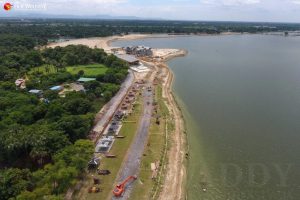Development for Whom?
By Burma Partnership • September 13, 2016
The impact of development projects on local communities and the environment in Burma has held considerable attention in the news over the last few weeks. On 26 August 2016, IFI Watch Myanmar, a local organization supporting the involvement of civil society and communities in monitoring the activities of international financial institutions, released a report entitled, “How Community Driven are CDD Projects in Myanmar?” on the implementation of the World Bank’s National Community Driven Development Project (NCDDP). According to the World Bank, the NCDDP strives “to enable poor rural communities to benefit from improved access to and use of basic infrastructure and services through a people-centered approach.” Rather than empowering local communities, however, IFI Watch Myanmar’s report shed light on the chronic lack of community consultation on the implementation of the NCDDP. In addition, the report exposed governance issues in the execution of the project, including reports of coercion of local communities, corruption, gender discrimination, and a lack of transparency.
Meanwhile, the Mon Youth Progressive Organization (MYPO) also released a report, titled “In the Balance,” which expressed similar concerns that the proposed dam projects along the Salween River – which runs through ethnic areas including Mon and Shan states – will be beneficial only to the investors, while the local community suffers the consequences. A MYPO researcher on the report, Mi Ah Chai, summarized the concerns, stating, “The Salween dams will provide no benefit for the local people, and will create irreversible environmental impacts to downstream ecosystems.” In a press conference, ethnic Shan, Mon and Karreni activists pointed out that, in the case of the Salween River dams in Shan State, 90% of all generated power would be exported to China and Thailand, with only the remaining 10% benefiting Burma. Further, activists suggested that the planning of dams in active conflict zones would only contribute to intensified fighting between ethnic armed organizations (EAOs) and the Burma Army. Without a clear outline on the ownership, use, and right to extract profits from the ethnic regions’ natural resources, as well as a stumbling peace process that has yet to guarantee a federal system of governance and equal rights for ethnic minority nationalities, tension between the Burma Army and EAOs in the regions around where the dams projects are being proposed is likely only going to increase.
Despite the criticism, the planned Salween River Naung Pha Dam in Shan State is reportedly failing to provide any public consultation during its Environmental and Social Impact Assessment. This goes against the demands of the Committee for Shan State Unity (CSSU) who, on 29 August 2016, condemned the Burma Government for going ahead with the Salween River dams, without considering their impact on local communities. The CSSU asserted, “Large dam projects threaten people’s lives, property and homes, and also destroy the ecological system. Just as the government has decided to review and suspend the Myitsone dam, we strongly urge the government to review the dam projects on the Salween River.”
The Chinese-backed Myitsone Dam was suspended in 2011 for similar concerns. Despite the displacement of thousands of local residents, the planning of the dam involved very little public consultation. Further, activists expressed concern that armed conflict in the region, between the Kachin Independence Army and the Burma Army, would only be prolonged by the construction of the project. The fact that the site of the Myitsone Dam sits on both an ecologically diverse and an earthquake prone region exacerbated public concerns for the project. Recently, a committee was formed to determine whether the Dam should be restarted, possibly as a result of pressure on Daw Aung San Suu Kyi’s Government to improve relations with China.
It appears, unfortunately, that little has improved since the Myitsone Dam was suspended in 2011 when it comes to development projects in Burma. Projects such as the Asian Development Bank’s (ADB’s) Asian Highway, which lacked Free, Prior and Informed Consent for affected communities and aggravated conflict in Karen State, will continue to persist without much deliberation or protest from the Burma Government and other stakeholders. Just recently, as many as 2,000 villagers have been displaced as a result of military operations by the Burma Army, which CSOs believe is a result of heightened tensions between armed groups brought on by the construction of the Asia Highway supported by the ADB in places like Karen State’s Hlaingbwe/Mae Thawaw Township.
However, without due consideration for the longer-term social and environmental impacts of these projects, any short-term gain will likely be superseded by longer lasting damage and exploitation. Burma must draw lessons from other developing countries where economic development based on exploitative natural resource extraction, or large-scale infrastructure projects that serve economic and political elites have failed to achieve the very intended goal itself. Development must be sustainable and inclusive, and this involves listening to the very people that will be most directly-affected by such projects, whether financed by private corporations, the state, or international financial institutions such as the World Bank and ADB.
Tags: Burma Partneship, Business and Human Rights, Dams, Economic Growth, Environmental issue, Ethnic Armed Organisations, Karen StateThis post is in: Blog
Related PostsBalancing Human Rights and Environmental Protection with Diplomacy and Investment









 All posts
All posts